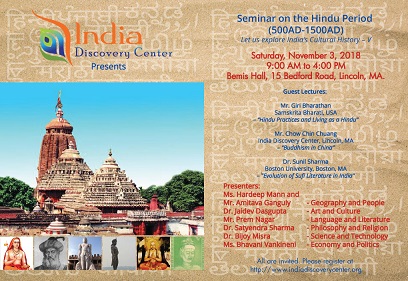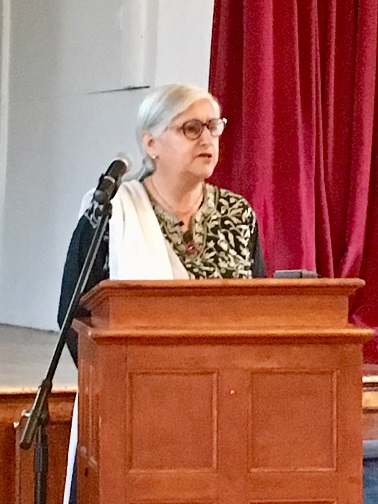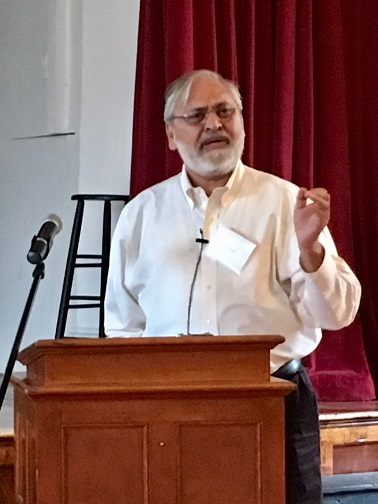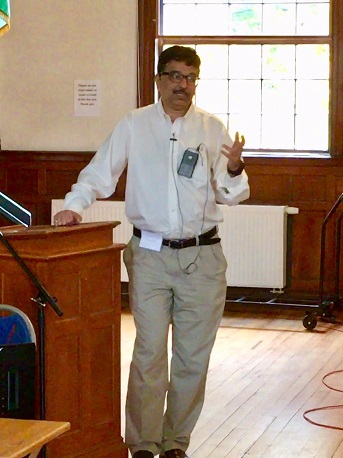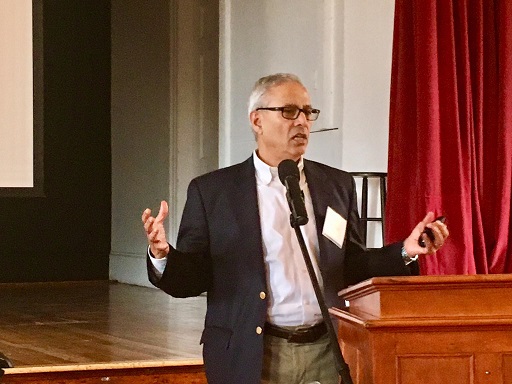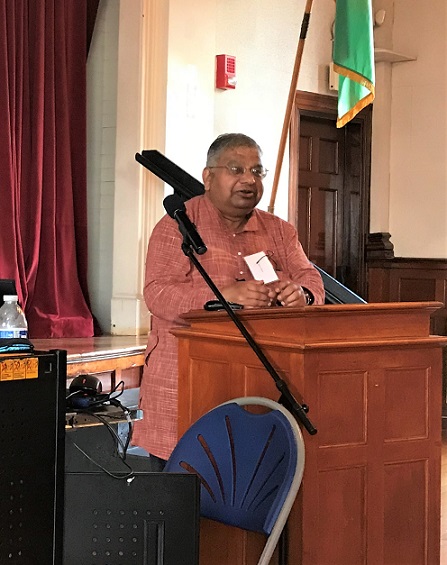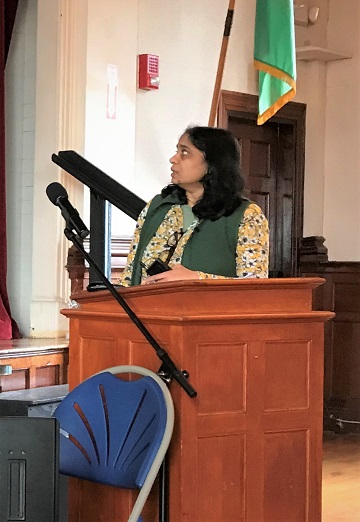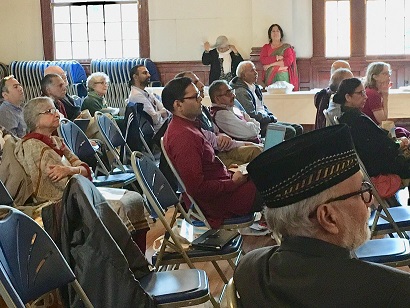Contribute
|
Seminar On The Hindu Period (500AD-1500AD) Part II – Summary Of The Presentations |
Prem Nagar
12/12/2018
Diversity and Cultural Creativity flourished in Medieval India: Report of the “Seminar on the Hindu Period (500AD-1500AD)†Part II – Summary of the Presentations This is Part II of a two-part report on the “Seminar on the Hindu Period (500AD-1500AD)†that was hosted by the India Discovery Center on Saturday, November 3, 2018 at Bemis Hall in Lincoln, MA. To access Part I of the report, click here. Laden with the exploration of diverse languages and massive educational institutions, innovative curiosity blossomed in all regions of India and in all segments of the population. Individually crafted products of high end designs in textiles, jewelry and household items were traded all around the globe; maritime traffic to the Far East was prolific; food grains were plentiful, and agricultural products were a premier export item. In addition to manufactured products, philosophy and culture spread rapidly, and was accepted through China and South Asia. Astronomy and mathematics helped to create navigation charts and sea traffic. The wealth imported from the trade of these items helped build massive temples and structures of exquisite artistry and majestic design. Temple-building also moved overseas, with massive structures constructed in Cambodia, Vietnam, Thailand and Indonesia. Indian artisans created a name for themselves, and glorified India in the world. There is reason to believe that the unleashing of human creativity was achieved via opulence in society and a respectful attitude towards individual freedom. Literature and poetry converged into voice renderings, as well as various genres of music and art. Folk art, folk dance and Folk Theater proliferated, and new renderings plus new versions in different regions of the country retold stories from the epics and from folk legends. India became a land of diversity that was engineered with elegant creativity. Tracks of Presentations: Presentations were made in six tracks. Geography and People dealt with the organization of different regions of the country, and the production potential of each region. The diversity of people and their settlements were discussed. This track was led by Ms. Hardeep Mann and Mr. Amitava Ganguly. The track on Language and Literature dealt with the development of Indian languages, for which the scripts and grammars were formalized. This track, led by Mr. Prem Nagar, contained literary expressions and surveyed compositions found in various languages of the country. The Philosophy and Religion track dealt with the process that dealt with the evolution of Indian philosophical doctrines, and their fusion with the religious systems. This tract surveyed many diversions of faith systems, which evolved by easy acceptance and tolerance. Dr. Satyendra Sharma led this track. The Art and Culture track dealt with the development of intricate beauty in stone and metals, with exquisite work in textiles. Cultural diversity became the norm, through personal expression and high standards of living. Dr. Jaidev Dasgupta was the presenter for the content of this track. The Science and Technology track continued with interconnecting earlier work on Mathematics, Astronomy, Prosody and Musicology. Technology was developed with new metal tools, alloys, medical science and marine navigation. This track was led by Dr. Bijoy Misra. And finally, the Economy and Politics track dealt with the produce markets, exports, imports, and taxation systems. Administrative arrangements were surveyed, to check how revenue was allocated. Ms. Bhavani Venkineni led this track. The seminar group preparation and the final slides were monitored and edited by Dr. Sonal Jhaveri, who was the Moderator for the presentations. Presentations Geography and People: Hardeep Mann The economy grew in different regions of the country, and led to strong regional kingdoms, which tried to create autonomous states in their local area. Agriculture expanded and increasing amounts of land were cultivated. Many different population centers were scattered through the country, each developing local styles of food, housing, textiles and architecture. The country was opulent, and in general it was peaceful. Hierarchical caste systems developed from local social attitude and took root: while this system helped the economy, it weakened the society, eventually allowing foreign invasions and occupation. Language and Literature: Prem Nagar The Hindu Period was noted for the development of most regional languages in India. While oral expressions and oral literature existed in all areas of the country in different forms, the spread of communication helped to create the grammar and to formalize the languages. Local scripts were developed following the basic Brahmi script, which gave rise to the Nagari script. Literature took to vocal rendering and melodic presentation of words and sentences. Elaborate texts were developed in poetics, prosody, art, architecture, philosophy, music and medicine. Epics were segmented into episodes, which were then rendered in local languages and were played out in the local context. Philosophy and Religion: Satyendra Sharma While the philosophical speculations of the early Upanisads, and of Buddhism and Jainism, led to the enunciation of Advaita philosophy by the Saint Shankara, religious belief systems turned theological. Secular thinking and self-expression created many sects, cults and paths in all faith systems. Tantra developed as a cosmological science and challenged the abstractions of philosophy. Religious pilgrimages became popular, sites and objects were declared holy. The multiplicity of faiths created a divided social structure, which then allowed Islam to penetrate. Eventually, Christianity entered via marine traffic and trade. Art and Culture – Jaidev Dasgupta Art flourished in different media, design and materials during this period of dynamism and growth. Action figures and events were depicted, as though they were alive Temple architecture developed via engineering plans, and via aesthetics that was conducive to the local culture. Stone carvings and designs led to new landscapes, and to self-contained walled structures. Art moved to literature, music and dance, leading to sophistication of expression in melody and theater. Textile art became very popular. The society was culturally rich with numerous social festivals and organized gatherings. Food, dress and jewelry took a regional slant, and became sophisticated in the local domain. Science and Technology – Bijoy Misra Aryabhatta conjectured the earth’s rotation through his observations, and Varahamihira estimated the distances of the planets from the Earth. Negative numbers and the concept of zero were proposed by Brahmagupta, and the mathematics of infinitesimals was worked out by Bhaskara. The theory of speech and communication was analyzed by Bhartrhari, then by Anadavardhana and Abhinavagupta. Poetics became a science, based on the theory that ideas could be conveyed through words and prosodic renderings. Musicology developed and led to the science of melody in music. Civil engineering and metallurgy attained new heights with the construction of tools, structures and jewelry. Boat-making helped with distant trade and brought wealth back home. Economy and Politics – Bhavani Venkineni Economy prospered through trade. Land reforms enabled individuals to own and develop land. Irrigation systems and cash crops were introduced, and agricultural products, spices and herbs were traded for horses, elephants and gold. Taxes varied, depending on the nature of the land, the produce and irrigation. North India was divided into various kingdoms, while the south was dominated by the Vijayanagar empire. The north was eventually occupied by the Turkish invaders who established the Delhi Sultanate. South India allowed village units and panchayats, while the north was ruled by the Sultan and his agents. The Sultanate created a differential tax system between Hindus and Muslims, and jurisprudence in the north also followed Islamic law. Question and Answer: The Q&A and the Discussions were lively, with great audience participation. In general, attendees wondered about the human conditions in the process of wealth creation: the conditions of women, the Sudras, the artisans or other laborers. The inequality and disparity in wealth did creep in. Social classification and labor in wealth production would be our interest in the next period. Also, why did Indian genius focus so minimally on warfare technology? The answer was not direct. Most probably utter creativity builds on local security and people don’t think of aggressive conduct. And finally, how did so many languages form that produced literature of unmatched quality, which is relevant even today? The answer could be that the regions used episodes from the epics and rendered them in the local conditions. The segments became literary pieces of beauty.
You may also access this article through our web-site http://www.lokvani.com/
